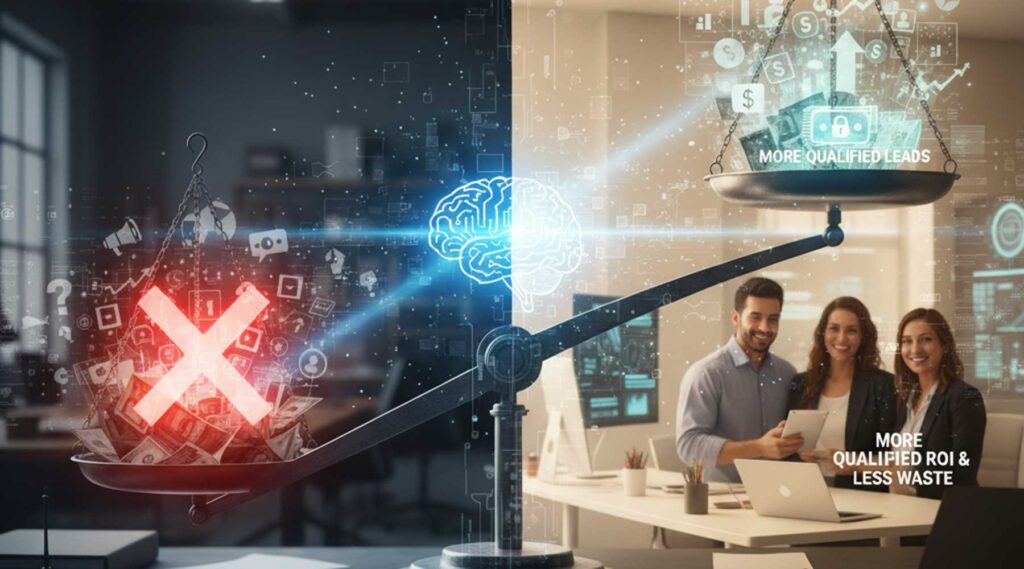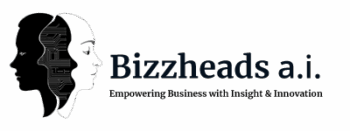
AI Marketing Efficiency defines the high-stakes balancing act of modern content today. Every business wants more qualified leads but fewer wasted dollars, yet traditional methods—spray-and-pray advertising, generic email blasts, and gut-feel strategies—burn through budgets without guaranteeing results. It’s time for small business owners to adopt precision-targeted campaigns that maximize ROI and cut down on waste.
Artificial Intelligence (AI) changes that equation. It empowers businesses to scale lead generation while cutting acquisition costs, turning marketing from a gamble into a precise, efficient system. This guide explains how AI can double your leads, halve your budget, and give you a competitive edge.
1. Why AI is Reshaping Marketing Strategy
AI is changing marketing from a guessing game into a precision-driven practice. It’s not just about moving faster—it’s about making more accurate and concrete choices.
By examining real-time behavioral data, AI can score leads to reveal which prospects have the highest likelihood of converting, allowing sales teams to prioritize their outreach.
It also refines personalization, dynamically adjusting ad copy, subject lines, or product recommendations so that every interaction feels tailor-made. At the same time, AI handles the heavy lifting of repetitive tasks—like audience segmentation, A/B testing, and campaign scheduling—freeing your team to focus on creative strategy and big-picture growth.
To maximize results, businesses should integrate predictive analytics dashboards, train chatbots with brand-specific language, and continuously refine models with fresh customer data. The payoff is clear: early adopters often achieve better results with more qualified leads in their pipeline within a year, while reducing their overall cost per lead. This proves that AI-driven marketing efficiency, guided by data, far outperforms marketing guided by instinct.
AI isn’t just about speed—it’s about smarter decision-making. By analyzing patterns in real time, AI tools can:
- Identify which prospects are most likely to convert.
- Tailor messaging so every interaction feels personal.
- Automate repetitive tasks so your team can focus on strategy.
The result? Marketing driven by data, not guesswork. Companies that adopt AI early often see 2–3x lead volume growth within the first year while spending less per lead.
2. Target the Right Audience Without Wasting Ad Spend
Overspending happens when ads target the wrong audience. AI Marketing Efficiency fixes this by:
- Lookalike Modeling: Using your best customers’ traits to find similar high-value prospects.
- Behavioral Tracking: Understanding browsing habits, search intent, and signals of purchase readiness.
- Dynamic Segmentation: Continuously updating audiences based on performance.
Instead of casting a wide net, AI narrows its focus to the buyers most likely to act.
3. Personalization That Scales
Generic marketing is dead. Today, customers expect tailored experiences at every step. AI makes personalization scalable:
- Adaptive Email Campaigns that shift tone and timing based on a recipient’s behavior.
- Product Recommendations that update in real time.
- Dynamic Website Content that adapts to each visitor.
Businesses using AI-driven personalization often see conversion rates rise 20–30%.
4. Smarter Funnel Management
A sales funnel is only as strong as its weakest link. AI enhances every stage:
- Lead Scoring ranks prospects so sales teams chase the most promising leads.
- Chatbots & Virtual Assistants qualify leads, answer FAQs, and book meetings 24/7.
- Predictive Analytics signals the exact moment a prospect is ready to buy.
The result is a seamless funnel that keeps leads moving instead of slipping away.
5. Real-Time ROI Tracking
ROI and Business Impact:
- $5.44 return for every $1 spent on marketing automation (544% ROI over three years – Nucleus Research)
- 10%+ boost in revenue within 6-9 months for companies using marketing automation (Comosoft)
- Companies using AI will pivot 75% of their staff’s operations from production to more strategic tasks (SEO.com)
Waiting until quarter-end to review results is outdated. AI-powered analytics provide:
- Real-time cost per qualified lead.
- Predictive lifetime value forecasts.
- Instant campaign adjustments when performance drops.
This keeps budgets lean and maximizes every marketing dollar.
6. Case for Efficiency: Doing More With Less
AI-driven marketing typically delivers:
- 30–50% lower campaign costs by cutting wasted ad spend. Madgicx (2025): This proactive approach typically reduces wasted spend by 30-50% and extends the profitable lifespan of successful campaigns. source: madgicx
- 2x to 3x more qualified leads with smarter targeting and personalization. CustomGPT (2025): “3.4x conversion on pricing page” and “Demo bookings up 156%” with personalized AI agents. customgpt
- Shorter sales cycles with predictive timing.
Competitors sticking to manual systems pay more and get less.
7. Getting Started With AI Marketing
You don’t need enterprise-level budgets to use AI. Entry points include:
- Email Marketing Platforms (like Mailchimp or HubSpot) with AI-driven optimization.
- Ad Platforms (Google, Meta) are already powered by machine learning for bidding and targeting.
- CRM Enhancements (Salesforce, Zoho) that add lead scoring and pipeline insights. We use Zoho, a chatbot and customer tracking software.
- Content Tools that draft copy variations and improve SEO.
The best approach? Start small in one area—email timing, ad targeting, or lead scoring—and scale up once you see ROI.
8. Future-Proofing Your Business
AI is advancing fast, and the gap between adopters and laggards will only widen. Businesses embracing AI now will:
- Capture market share by converting more efficiently.
- Deliver customer experiences that feel tailor-made.
- Spend less to achieve more.
Those clinging to outdated strategies will overspend and underperform.
Conclusion
Doubling your leads while halving your budget isn’t a dream—it’s the practical result of adopting AI-driven marketing efficiency. From smarter targeting to predictive insights and scalable personalization, AI takes the guesswork out of growth. Read how to use AI in your startup.
Every dollar you spend should work harder. With AI, it does. The future of marketing belongs to businesses that adopt these tools today.
Frequently Asked Questions (FAQ)
1. How exactly does AI reduce marketing costs?
AI cuts costs by eliminating wasted ad spend, automating repetitive tasks, and ensuring campaigns target only high-intent prospects. This allows businesses to spend less while achieving higher returns.
2. Is AI marketing only for big companies with large budgets?
No. Many AI tools are designed for small and mid-sized businesses. Email marketing platforms, CRMs, and ad managers already have built-in AI features accessible to smaller teams.
3. Can AI replace human marketers?
AI is a tool, not a replacement. It handles data analysis, targeting, and automation, but human creativity and strategy are still essential for effective campaigns.
4. How soon can I expect results after implementing AI?
In many cases, businesses see improvements within weeks—especially in targeting efficiency and lead quality. Larger transformations may take a few months as data accumulates.
5. What’s the best first step in adopting AI marketing?
Start with one high-impact area—such as improving ad targeting or personalizing email campaigns. Once you see measurable ROI, expand AI usage across your funnel.
Write for us
Blog post submission
